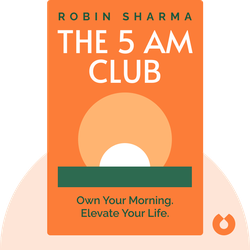Try Blinkist to get the key ideas from 7,000+ bestselling nonfiction titles and podcasts. Listen or read in just 15 minutes.
Start your free trial
Blink 3 of 8 - The 5 AM Club
by Robin Sharma

An Astrophysical Tour
Welcome to the Universe by Neil deGrasse Tyson, Michael A. Strauss and J. Richard Gott is a comprehensive guide that takes readers through an immersive exploration of the universe; from planets, stars, galaxies to black holes and more.
Okay, first stop. Lower Earth orbit.
Before heading out any further, we need to get you situated with our starting point – Earth. Our little blue marble of life. For many of you, this will seem like your very first trip to space. But in reality, you’ve been rocketing through space all your lives. Because, realize it or not, we’re all living on a rock moving roughly 100,000 kilometers per hour through our solar system. And in that sense, Earth already is a kind of spaceship.
Now, looking at Earth from space, I’m going to ask that everyone tilt their heads just slightly to the right. That’s it. It’s only now that you’re actually looking at our planet head-on. This is because as Earth orbits the sun, it’s perpetually tilted at an angle of 23.5°. As we orbit the sun once a year, Earth keeps a constant tilt, maintaining the exact same orientation for the entire journey.
Alright, now look toward the edges of Earth. See that creeping shadow? Well as you might have guessed, that’s the night beginning for those parts of Earth. But, what you might not realize, unless you’re looking at Earth head-on, is that it’s always exactly 50 percent covered in sunlight and exactly 50 percent in darkness. Forget daylight saving time, long winters, summer solstices, that’s just where you happen to be located on this tilt. People in Antarctica can see daylight for 24 hours in December . . . but Earth as a whole? Without exception, it’s always 50/50.
And it’s this very tilt that dictates everything we know about the sky. From the stars we see, to the path of the sun. Many people believe that high noon means the sun is directly overhead. But, in fact, if you’re looking from the US, you’ll never, at no point of day or year, experience the sun directly over your head. It just doesn’t happen. Because in the US, you’re always witnessing the sun at an angle. This also means you’ll never see all the same star constellations that the Southern Hemisphere does, and vice versa.
So, if you can all untilt your necks . . . now we’re situated and looking straight ahead. It’s time to start our tour through space at our solar system’s crown jewel – the sun.



Welcome to the Universe (2016) is a mind-blowing and breathtaking introduction to astrophysics, based on the popular course the three authors cotaught at Princeton University. It takes everyone – even the nonscience-minded – on a trip through the known universe, stopping to examine stars, galaxies, black holes, and more, all while presenting fascinating theories regarding time travel, the big bang, and the prospect of life in other galaxies.
Welcome to the Universe (2016) takes readers on an exhilarating journey through the cosmos, offering an accessible and captivating exploration of astronomy and astrophysics. Here's why this book is worth reading:
It's highly addictive to get core insights on personally relevant topics without repetition or triviality. Added to that the apps ability to suggest kindred interests opens up a foundation of knowledge.
Great app. Good selection of book summaries you can read or listen to while commuting. Instead of scrolling through your social media news feed, this is a much better way to spend your spare time in my opinion.
Life changing. The concept of being able to grasp a book's main point in such a short time truly opens multiple opportunities to grow every area of your life at a faster rate.
Great app. Addicting. Perfect for wait times, morning coffee, evening before bed. Extremely well written, thorough, easy to use.
Try Blinkist to get the key ideas from 7,000+ bestselling nonfiction titles and podcasts. Listen or read in just 15 minutes.
Start your free trial
Blink 3 of 8 - The 5 AM Club
by Robin Sharma
What is the main message of Welcome to the Universe?
Discover the fascinating wonders of the universe in Welcome to the Universe.
How long does it take to read Welcome to the Universe?
The reading time for Welcome to the Universe varies depending on the reader's speed. However, the Blinkist summary can be read in just 15 minutes.
Is Welcome to the Universe a good book? Is it worth reading?
Welcome to the Universe is a captivating and educational book that is definitely worth reading.
Who is the author of Welcome to the Universe?
The authors of Welcome to the Universe are Neil deGrasse Tyson, Michael A. Strauss, and J. Richard Gott.